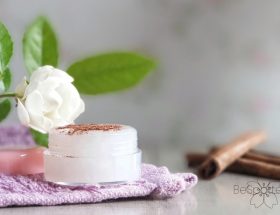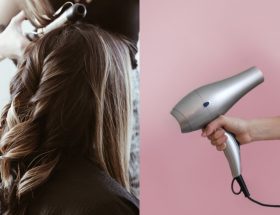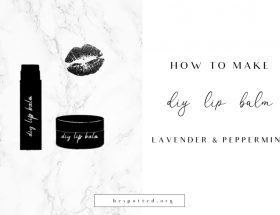This post may contain affiliate links. Any sales made through such links will reward me a small commission – at no extra cost for you!
How to get rid of acne – tips and tricks to get clear, acne-free skin once and for all…
What Is Acne?
Acne is a common skin condition. Those little red bumps we hope to leave in our teenage years, but are often present until deep into adulthood.
The process of forming acne is very simple. The sebaceous glands produce sebum that comes out through the pores and helps in moisturizing the skin.
But, if the pores are blocked with dirt, dead skin cells and bacteria, the sebum can’t come out. The problem is only worse if the sebaceous glands produce more oil than your skin needs (i.e. if you have oily skin type).
Now all of that sebum, dirt and bacteria is trapped inside the pores. The bacteria start to multiply and eventually cause an infection. What you get is a small pile of pus under the surface of your skin, and the infection makes the spot red, swollen, sensitive and sometimes painful to touch.
And voila – you have a fully developed acne.
What Causes Acne?
Not exfoliating your skin regularly can lead to clogged pores, which can cause acne and blackheads. There are also pollution, genetics and everything that causes excess sebum production.
The number one thing that causes excess oil production is hormonal changes. That is why you can pretty much expect acne to appear during puberty, pregnancy and just before your monthly period, as well after stressful situations and events.
But in some cases, it can be very hard to get rid of acne even years after the puberty or pregnancy.
It seems that experts still can’t agree whether certain food can impact our skin. Most seem to believe, though, that food (especially milk, because it contains hormones, and any food that can spike insulin production) cannot cause acne but can make matters worse if they already exist.
What Cosmetics Can Help You Get Rid of Acne?
If you are trying to get rid of acne, regular, consistent skincare routine is absolutely crucial.
But, while it is necessary to include products and ingredients meant to help you get rid of acne, it is equally important to choose the ones that won’t make matters worse.
Unfortunately, we are still in a transition period where many still take misconceptions from 15 – 20 years ago as the best practice. You can find some really weird advices all over the internet.
But it is also an era where dermatologists’ and estheticians’ voice started to reach more and more people. And their opinion came as simple as it is surprising – mild, gentle, persistent routine can take you far further than some harsh let’s-destroy-acne-overnight approach.
Cleanser
It may seem, since your skin is oily, you need a cleanser that would strip all the oil and bacteria away, but that is not the case. These cleansers can disrupt the pH balance of your skin and severely dry it out. In response, your skin will start producing even more sebum, making it even harder for you to get rid of acne.
Avoid cleansers that contain soap, alcohol or sulfates, since they can be too drying. Also, you won’t need anything that makes too much foam.
Try to find a mild gel cleanser, suitable to use twice a day. It can contain salicylic acid or benzoyl peroxide. Both of these ingredients are the first choice when you’re trying to get rid of acne, but cleansers that contain both of them might also be too drying.
Experiment to see which one suit you better. Or combine – if, for example, your spot treatment contains benzoyl peroxide, choose a cleanser based on salicylic acid.
Oil cleansing is another method you can try out. This technique has gained a lot of followers since it has shown some remarkable results in treating acne.
Scrub
If you are using anti-acne skincare products, chances are you are already exfoliating your skin. Many of these products contain substances that dissolve dead skin cells.
So before you start vigorously scrubbing your face, check if your beauty products contain salicylic acid, benzoyl peroxide, retinol, AHA… If yes, your skin already gets exfoliation and additional harsh scrubbing can do much more damage than it can help you get rid of acne.
That said, for some of us these products are not enough to completely remove that dead skin layer from the face. Using mild mechanical scrub once a week can do a lot for your skin. But, it’s important for it to be gentle, small grain scrub that will not upset already irritated skin.
Toner
There shouldn’t be a day that you don’t apply a face toner.
When they first appeared, toners gained the reputation of being too drying. That’s why many people avoided using them. These days, not only toners don’t dehydrate the skin, but can be very hydrating.
Choose a toner that contains AHA acids, especially if your cleanser doesn’t contain any. AH acids are exfoliators that dissolve all dead skin cells and get you rid of that dull layer of your skin that can clog your pores.
Also, try to find a toner with good astringent properties. It will shrink your pores, which will give you better looking, poreless skin. There will also be less chance that the pores will get filled with oil, dirt and bacteria, which will help you get rid of acne fast and permanently.
Spot Treatment
Spot treatments are potent, concentrated products that should be applied directly to acne to help it heal faster. They are not suitable for the rest of your skin since they can dry it out. However, the combination of drying and antibacterial properties should be able to get rid of acne.
Renée Rouleau, an esthetician and founder of Renée Rouleau Skin Care Collection, has her own approach when it comes to this type of products. She says a spot treatment should be applied only after the extraction, because otherwise it can keep the acne pus from coming out naturally.
It actually makes a lot of sense and she explained the whole process in her article Why Most Acne Spot Treatments DON’T Work.
Moisturizer
Many moisturizers for acne prone skin are too drying and, if you cleaned your face properly, quite frankly – that is not what you need. It would also be a huge mistake not to use moisturizer at all.
Your skin needs hydration. Not moisturizing it not only won’t help you get rid of acne, but can make them worse.
The important thing to have in mind is not to use heavy, thick moisturizers. Anything that can clog your pores is out of option. Instead, use lightweight facial creams or gel moisturizers.
As for ingredients, you will need a mix of hydrating and soothing substances. Look for hyaluronic acid, squalane, ceramides, vitamin C, niacin, chamomile extract and aloe vera gel.
Retinol is often recommended for acne prone skin, but you should only use it at night. During the day, it can increase skin sensitivity to the sun.
As for your day cream, always use a moisturizer with SPF.
Face Mask
For acne prone skin, clay is always the first choice since its fine particles can collect any excess oil, dirt and bacteria from your skin. Using a clay mask at least once a week can help you cleanse your skin, detoxify it and get rid of acne and blackheads.
You can even make your own DIY clay mask for acne prone skin.
Apart from deep cleansing, your skin will also need a lot of hydration – it’s no secret that oily, acne prone skin is often very dehydrated. So make sure to include hydrating mask into your weekly routine as well.
Your best choice would be some light gel mask that can deeply hydrate your skin without clogging your pores.
When Should You Pop Acne?
If I said never, would that stop you?
Exactly. So, at least do it properly.
The first rule is to never ever pop acne unless you can see the pus right beneath the surface. If it is a cystic acne, with the pus deep in the skin, and all you see is big, red, swollen bump with no white tip, leave it alone!
Seriously! Popping something so deep will leave a scar, and then there’s nothing you can do to remove it.
If the white tip is clearly under a very thin layer of skin, first press a warm compress against the acne for a couple of minutes to make it softer and easier to extract. Wrap a tissue around your fingers and press down on the sides of acne.
Try moving your fingers around it and pressing the acne from many different angles. If it doesn’t come out easily, leave it alone and try again the next day.
Once you extracted everything, press an ice cube over the spot to calm the irritation. Apply spot treatment to help it heal faster.
Makeup for Acne Prone Skin
These days you can find a lot of makeup containing ingredients that promise to help you get rid of acne. However, if you’re already using cosmetics that do the same, this kind of makeup can over-dry your skin.
Don’t expect from your makeup to have many different functions; instead find some that is good in its primary job – to cover imperfections, even out your skin tone and look natural. If you’ve found one that does all of that, and is light and non-comedogenic, stick to it.
After cleansing your face and applying your daily cream (with SPF), cover the whole face in lightweight foundation. Once you even out your skin a bit, apply concealer only to your acne and lightly dab it with your finger to blend it evenly. Finish with a powder suitable for your skin tone.
That’s it. Three easy steps and, if you’ve used the right products, I guaranty even you won’t be able to point at your acne.
I cannot stress enough how important it is to remove all the makeup before going to bed – every night, no excuses!
What Food Might Worsen Your Acne?
Sad but true, food does affect the condition of our skin. Well, maybe not so sad if you’re chewing carrots for snack. The rest of us, though… Yup, we’re screwed.
The chances are the food won’t cause them, but it can make it much, much harder to get rid of acne that are already there. Plus, not all people react equally to different food and what works for your friends might not work for you.
So, if you don’t know what food makes you break out, how can you know what to cut out? Well, just be patient and listen to your own body.
The best thing you can do is cut out some of the possible triggers for several weeks. Then watch your skin to see how it reacts to that change. Don’t expect to completely get rid of acne this way, but track if they at least start to retreat.
Where to start from? This is the list of the food known for causing breakouts and it is quite possible some of it causes yours too:
- milk and dairy products – contain hormones;
- carbs and sugar – increase insulin levels;
- caffeine – not only it can increase the stress level, but consuming a lot of coffee can dehydrate your skin. Considering that oily skin is often very dehydrated, you should definitely limit your coffee intake to 1 – 2 cups a day;
- chocolate – contains sugar, milk and caffeine;
- food rich in iodine;
- all sorts and types of fast, fatty, spicy and fried food;
- soda and alcohol – amongst many, many reasons why you should cut them out, soda contains caffeine and sugar, and alcohol dehydrates your skin.
Most of us don’t have to completely cut out this food to get rid of acne. You’ll probably have to significantly limit whatever worsens your acne and replace it with fresh fruit and veggies, lean meat (skinless chicken or turkey), a lot of water and a cup or two of spearmint tea a day.
But a piece of chocolate here and there won’t kill you.
Small Everyday Things to Keep In Mind
Some other things to consider are all the things that touch your face multiple times a day. Stuff like your pillowcase, your phone or hair products you put on the strands that often fall over your face.
All of these things have dirt and bacteria on them, or in case of hair products – heavy substances that can clog your pores. And though it’s not likely any of them will cause acne or blackheads, they can make things worse if you’re already breaking out.
However, you can’t just stop touching everything, nor should you. Just keep those things around you clean, like anyone should, acne or not.
Going into extremes can not only make you miss out on all the fun, but can also be counterproductive. After all, to get rid of acne, your face should be clean, not sterile.














My sister would like to get rid of the acne on her cheeks, which is why she would like to go to a dermatologist. Well, thank you for sharing here that a mild gel cleanser will be an ideal solution for acne. It’s also a good thing that you shared here the importance of wearing a clay mask and applying moisturizer.
Glad you found it helpful… ❤️